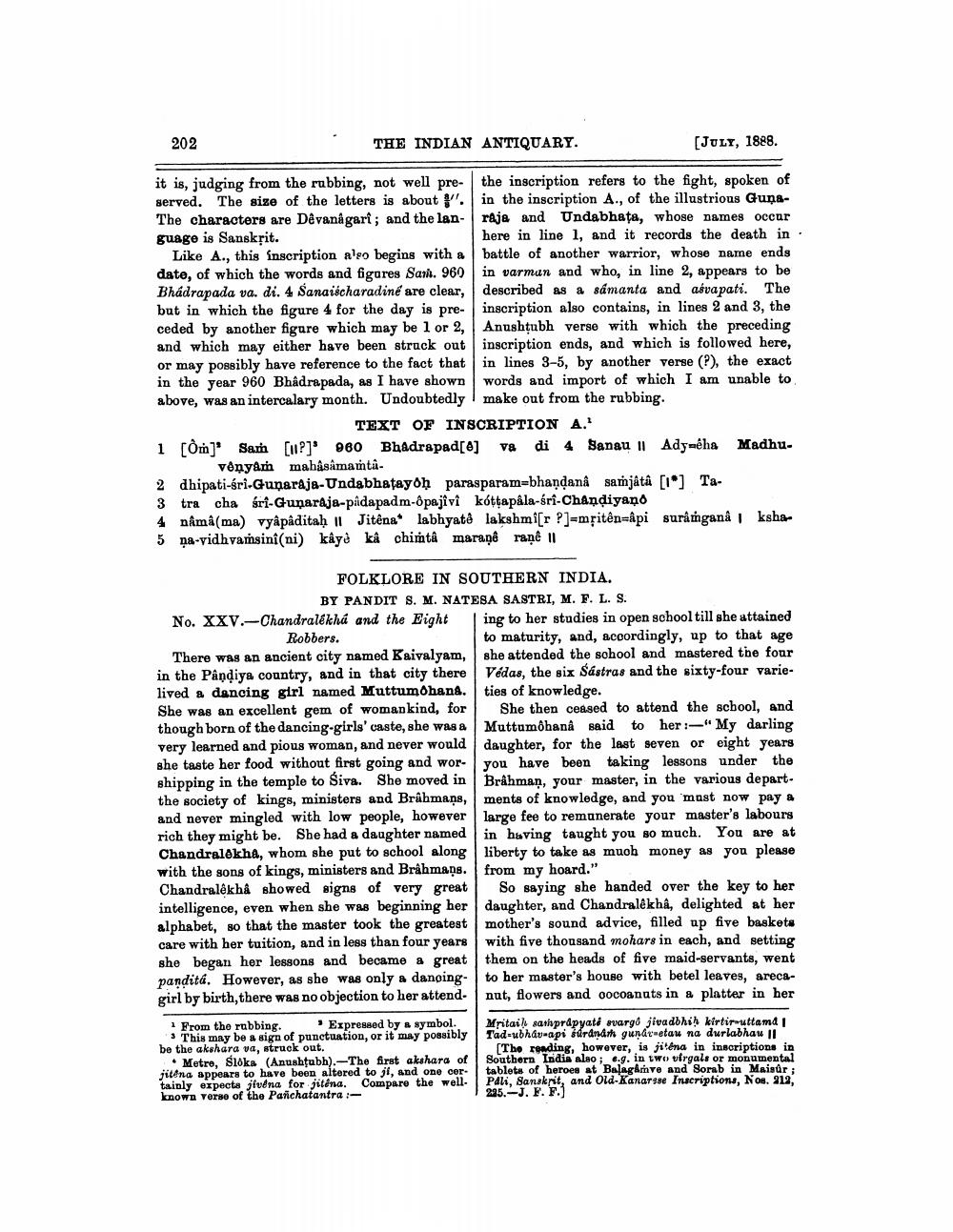________________
202
THE INDIAN ANTIQUARY.
[JULY, 1888.
it is, judging from the rubbing, not well pre- the inscription refers to the fight, spoken of served. The size of the letters is about y. in the inscription A., of the illustrious GunaThe characters are Devanagari; and the lan- raja and Undabhata, whose names occur guage is Sansksit.
here in line 1, and it records the death in. Like A., this inscription also begins with a battle of another warrior, whose name ends date, of which the words and figures Sanh. 960 in varman and who, in line 2, appears to be Bhadrapada va. di. 4 Sanaiécharadiné are clear, described as a sámanta and aśva pati. The but in which the figure 4 for the day is pre- inscription also contains, in lines 2 and 3, the ceded by another figure which may be 1 or 2, Anushțubh verse with which the preceding and which may either have been struck out inscription ends, and which is followed here, or may possibly have reference to the fact that in lines 3-5, by another verse (), the exact in the year 960 Bhadrapada, as I have shown words and import of which I am unable to above, was an intercalary month. Undoubtedly make out from the rubbing.
TEXT OF INSCRIPTION A. 1 [Òm]' Sam [11?]' 060 Bhadrapad[0] Va di 4 Sanau || Adyéha Madhu
vényám mahasåmamtà. 2 dhipati-sri-Gunaraja-Undabhatayoh parasparam=bhandanå samjátâ [1 ] Ta3 tra cha sri-Gunaraja-pidapadm-Opajivi kottapala-sri-Chandiyano 4 nâmâ(ma) vyâpâditaḥ || Jitêna* labhyatê lakshmi[r ?]=mpitên=&pi surâmingana 1 ksha5 na-vidhvamsini(ni) kâye kâ chimta maranê ranê 11
FOLKLORE IN SOUTHERN INDIA.
BY PANDIT S. M. NATESA SASTRI, M. F. L. S. No. XXV.-Chandralekha and the Eight ing to her studies in open schooltill she attained Robbers.
to maturity, and, accordingly, up to that age There was an ancient city named Kaivalyam, she attended the school and mastered the four in the Pâņdiya country, and in that city there Vedas, the six Śástras and the sixty-four varielived a dancing girl named MuttumOhana. ties of knowledge. She was an excellent gem of womankind, for | She then ceased to attend the school, and though born of the dancing-girls' caste, she was a Muttumôhana said to her :-"My darling very learned and pious woman, and never would daughter, for the last seven or eight years she taste her food without first going and wor- you have been taking lessons under the shipping in the temple to Siva. She moved in Brâhman, your master, in the various depart. the society of kings, ministers and Brâhmans, ments of knowledge, and you mast now pay a and never mingled with low people, however large fee to remunerate your master's labours rich they might be. She had a daughter named in having taught you so much. You are at Chandralekha, whom she put to school along liberty to take as muoh money as you please with the sons of kings, ministers and Brahmans. from my hoard." Chandralekha showed signs of very great | So saying she handed over the key to her intelligence, even when she was beginning her daughter, and Chandralekhâ, delighted at her alphabet, so that the master took the greatest mother's sound advice, filled up five baskets care with her tuition, and in less than four years with five thousand mohars in each, and setting she began her lessons and became a great them on the heads of five maid-servants, went panditá. However, as she was only a dancing- to her master's house with betel leaves, arecagirl by birth, there was no objection to her attend. nut, flowers and cocoanats in & platter in her
From the rubbing. Expressed by a symbol.. > This may be a sign of punctuation, or it may possibly be the akshara va, struck out.
• Metre, sloka (Anushtabh).-The first akshara of jitana appears to have been altered to jl, and one cer- tainly expects judna for jiténa. Compare the well- known verse of the Panchatantra :
Mritail sarvprapyati svargi jivadbhi kirtir-uttamdi Tad-ubhav-api saranan gunde etau na durlabhau 11
[The reading, however, is jilena in inscriptions in Southern India alao; .g. in two vfrgals or monumental tablets of heroes at Balagkrve and Sorab in Maisur Pali, Sanskrit, and Old-Kanarsse Inscriptions, Nos. 912, 225.-J. F.F.)




